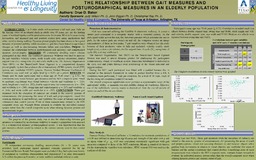
ATTENTION: The works hosted here are being migrated to a new repository that will consolidate resources, improve discoverability, and better show UTA's research impact on the global community. We will update authors as the migration progresses. Please see MavMatrix for more information.
Show simple item record
| dc.contributor.author | Baker, Drue | en_US |
| dc.date.accessioned | 2012-06-11T19:03:44Z | en_US |
| dc.date.available | 2012-06-11T19:03:44Z | en_US |
| dc.date.issued | 2012-06-11 | en_US |
| dc.identifier.uri | http://hdl.handle.net/10106/9860 | en_US |
| dc.description.abstract | 1 in 3 older adults will experience a fall each year. Falls are the leading cause of accidental death in adults over 65 years, and are the leading cause of nonfatal injuries and hospital admissions for trauma. Most falls occur during locomotion, and impaired gait and postural control have many implications that affect stability during walking. Dynamic posturography has been shown to be a good measure of postural stability, while measures of gait have been linked to age-related changes as well as discriminating between fallers and non-fallers | en_US |
| dc.description.sponsorship | Wilson, Judy, Ph.D. | en_US |
| dc.description.sponsorship | Biggan, John, Ph.D. | en_US |
| dc.description.sponsorship | Ray, Christopher, Ph.D. | en_US |
| dc.language.iso | en_US | en_US |
| dc.subject | Sensory Organization Test | en_US |
| dc.subject | gait measures | en_US |
| dc.subject | posturographical measures | en_US |
| dc.title | The relationship between gait measures and posturographical measures in an elderly population | en_US |
| dc.type | Presentation | en_US |
| dc.publisher.department | Department of Kinesiology, The University of Texas at Arlington | en_US |
| dc.publisher.department | Center for Healthy Living and Longevity, The University of Texas at Arlington | en_US |
Files in this item
- Name:
- Relationship between gait ...
- Size:
- 1.139Mb
- Format:
- PDF
- Description:
- PDF
This item appears in the following Collection(s)
Show simple item record


